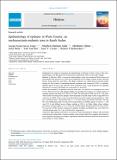Epidemiology of epilepsy in Wulu County, an onchocerciasis-endemic area in South Sudan
Publication Date
2024-09-10Type
Article, Journalviews
downloads
Metadata
Show full item recordCitation
TY - JOUR AU - Siewe Fodjo, Joseph Nelson AU - Jada, Stephen AU - Taban, Abraham AU - Bebe, John AU - Bol, Yak AU - Carter, Jane AU - Colebunders, Robert PY - 2024/09/01 SP - e37537 T1 - Epidemiology of epilepsy in Wulu County, an onchocerciasis-endemic area in South Sudan VL - 10 DO - 10.1016/j.heliyon.2024.e37537 JO - Heliyon ER -
Abstract/
Background: We sought to investigate the epidemiology of epilepsy in Wulu County (Lakes State, South Sudan), and document the onchocerciasis transmission status in the study villages. Methods: In February 2024, a community-based epilepsy study was conducted Wulu County and participants were surveyed via a door-to-door approach in five villages, namely: Kombi, Makundi Center, Tonjo, War-Pac, and Woko. All village residents were asked about ivermectin intake during the 2023 round of community-directed treatment with ivermectin (CDTI). In addition, children aged 3–9 years were tested for Ov16 antibodies using a rapid diagnostic test. Epilepsy diagnosis in screened individuals was confirmed by a physician. Results: We surveyed 1355 persons in the five study sites. The overall CDTI coverage in 2023 was 67.4 %. Fifty-five persons with epilepsy (PWE) were identified (prevalence 4.1 %) and a history of nodding seizures was noted in 11/55 (20 %) PWE. The mean age of PWE was 21.5 ± 9.6 years,with 32 (58.2 %) being males. Epilepsy onset frequently occurred under 5 years of age (38.6 % of cases). In two PWE, seizure onset occurred during the past 12 months (annual incidence: 147.6 per 100,000 persons). Twenty-nine PWE (52.7 %) were taking anti-seizure medicines, but only five were taking them daily. Overall, Ov16 seroprevalence in children aged 3–9 years (n = 119)was 15.1 % and differed across villages, peaking at 30.9 % in Woko village where epilepsy prevalence was also highest (7.1 %). Of the 35 recorded deaths during the past two years, 9 (25.7 %) occurred in PWE. Annual estimates for epilepsy mortality and fatality rates were 323.7 per 100,000 persons and 7031.3 per 100,000 PWE, respectively. Conclusion: High epilepsy prevalence was found in Wulu, particularly in villages with persistent onchocerciasis transmission. Frequent epilepsy onset among under-fives suggests that perinatal/ early childhood etiologies are common. Appropriate measures should be instituted to prevent and treat epilepsy in Wulu villages.

